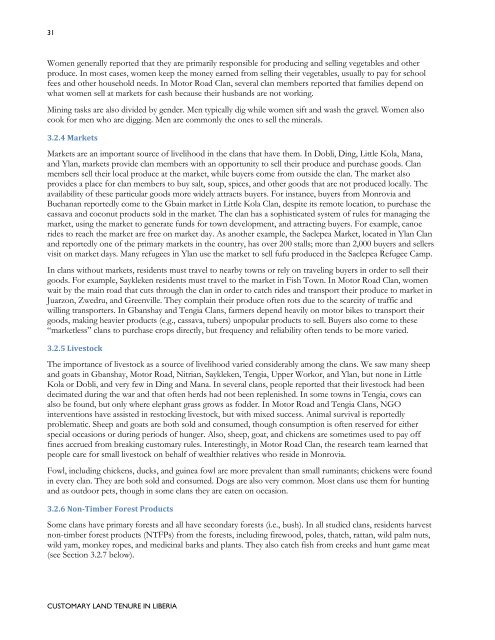Customary Land Tenure in Liberia - Land Tenure and Property ...
Customary Land Tenure in Liberia - Land Tenure and Property ...
Customary Land Tenure in Liberia - Land Tenure and Property ...
You also want an ePaper? Increase the reach of your titles
YUMPU automatically turns print PDFs into web optimized ePapers that Google loves.
31<br />
Women generally reported that they are primarily responsible for produc<strong>in</strong>g <strong>and</strong> sell<strong>in</strong>g vegetables <strong>and</strong> other<br />
produce. In most cases, women keep the money earned from sell<strong>in</strong>g their vegetables, usually to pay for school<br />
fees <strong>and</strong> other household needs. In Motor Road Clan, several clan members reported that families depend on<br />
what women sell at markets for cash because their husb<strong>and</strong>s are not work<strong>in</strong>g.<br />
M<strong>in</strong><strong>in</strong>g tasks are also divided by gender. Men typically dig while women sift <strong>and</strong> wash the gravel. Women also<br />
cook for men who are digg<strong>in</strong>g. Men are commonly the ones to sell the m<strong>in</strong>erals.<br />
3.2.4 Markets<br />
Markets are an important source of livelihood <strong>in</strong> the clans that have them. In Dobli, D<strong>in</strong>g, Little Kola, Mana,<br />
<strong>and</strong> Ylan, markets provide clan members with an opportunity to sell their produce <strong>and</strong> purchase goods. Clan<br />
members sell their local produce at the market, while buyers come from outside the clan. The market also<br />
provides a place for clan members to buy salt, soup, spices, <strong>and</strong> other goods that are not produced locally. The<br />
availability of these particular goods more widely attracts buyers. For <strong>in</strong>stance, buyers from Monrovia <strong>and</strong><br />
Buchanan reportedly come to the Gba<strong>in</strong> market <strong>in</strong> Little Kola Clan, despite its remote location, to purchase the<br />
cassava <strong>and</strong> coconut products sold <strong>in</strong> the market. The clan has a sophisticated system of rules for manag<strong>in</strong>g the<br />
market, us<strong>in</strong>g the market to generate funds for town development, <strong>and</strong> attract<strong>in</strong>g buyers. For example, canoe<br />
rides to reach the market are free on market day. As another example, the Saclepea Market, located <strong>in</strong> Ylan Clan<br />
<strong>and</strong> reportedly one of the primary markets <strong>in</strong> the country, has over 200 stalls; more than 2,000 buyers <strong>and</strong> sellers<br />
visit on market days. Many refugees <strong>in</strong> Ylan use the market to sell fufu produced <strong>in</strong> the Saclepea Refugee Camp.<br />
In clans without markets, residents must travel to nearby towns or rely on travel<strong>in</strong>g buyers <strong>in</strong> order to sell their<br />
goods. For example, Saykleken residents must travel to the market <strong>in</strong> Fish Town. In Motor Road Clan, women<br />
wait by the ma<strong>in</strong> road that cuts through the clan <strong>in</strong> order to catch rides <strong>and</strong> transport their produce to market <strong>in</strong><br />
Juarzon, Zwedru, <strong>and</strong> Greenville. They compla<strong>in</strong> their produce often rots due to the scarcity of traffic <strong>and</strong><br />
will<strong>in</strong>g transporters. In Gbanshay <strong>and</strong> Tengia Clans, farmers depend heavily on motor bikes to transport their<br />
goods, mak<strong>in</strong>g heavier products (e.g., cassava, tubers) unpopular products to sell. Buyers also come to these<br />
“marketless” clans to purchase crops directly, but frequency <strong>and</strong> reliability often tends to be more varied.<br />
3.2.5 Livestock<br />
The importance of livestock as a source of livelihood varied considerably among the clans. We saw many sheep<br />
<strong>and</strong> goats <strong>in</strong> Gbanshay, Motor Road, Nitrian, Saykleken, Tengia, Upper Workor, <strong>and</strong> Ylan, but none <strong>in</strong> Little<br />
Kola or Dobli, <strong>and</strong> very few <strong>in</strong> D<strong>in</strong>g <strong>and</strong> Mana. In several clans, people reported that their livestock had been<br />
decimated dur<strong>in</strong>g the war <strong>and</strong> that often herds had not been replenished. In some towns <strong>in</strong> Tengia, cows can<br />
also be found, but only where elephant grass grows as fodder. In Motor Road <strong>and</strong> Tengia Clans, NGO<br />
<strong>in</strong>terventions have assisted <strong>in</strong> restock<strong>in</strong>g livestock, but with mixed success. Animal survival is reportedly<br />
problematic. Sheep <strong>and</strong> goats are both sold <strong>and</strong> consumed, though consumption is often reserved for either<br />
special occasions or dur<strong>in</strong>g periods of hunger. Also, sheep, goat, <strong>and</strong> chickens are sometimes used to pay off<br />
f<strong>in</strong>es accrued from break<strong>in</strong>g customary rules. Interest<strong>in</strong>gly, <strong>in</strong> Motor Road Clan, the research team learned that<br />
people care for small livestock on behalf of wealthier relatives who reside <strong>in</strong> Monrovia.<br />
Fowl, <strong>in</strong>clud<strong>in</strong>g chickens, ducks, <strong>and</strong> gu<strong>in</strong>ea fowl are more prevalent than small rum<strong>in</strong>ants; chickens were found<br />
<strong>in</strong> every clan. They are both sold <strong>and</strong> consumed. Dogs are also very common. Most clans use them for hunt<strong>in</strong>g<br />
<strong>and</strong> as outdoor pets, though <strong>in</strong> some clans they are eaten on occasion.<br />
3.2.6 Non-Timber Forest Products<br />
Some clans have primary forests <strong>and</strong> all have secondary forests (i.e., bush). In all studied clans, residents harvest<br />
non-timber forest products (NTFPs) from the forests, <strong>in</strong>clud<strong>in</strong>g firewood, poles, thatch, rattan, wild palm nuts,<br />
wild yam, monkey ropes, <strong>and</strong> medic<strong>in</strong>al barks <strong>and</strong> plants. They also catch fish from creeks <strong>and</strong> hunt game meat<br />
(see Section 3.2.7 below).<br />
CUSTOMARY LAND TENURE IN LIBERIA

















